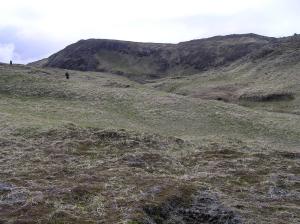Author: Diane K. Hanson| University of Alaska Anchorage|dkhanson@uaa.alaska.edu
The first upland sites recorded in the Aleutian Islands were discounted by some researchers as World War II features, or materials dumped in upper elevations by construction, or artifacts dropped by collectors. This was partly because there was an assumption that terrestrial resources were not particularly important to Unangax^ people and there would be little reason to venture far from the coast, even though there were historic accounts of people using trails across the islands, hunting birds, and gathering rock for making tools.
It wasn’t until the 1980s and 1990s that more archaeologists began recording upland features. Beginning in 2007, archaeologists from the University of Alaska Anchorage started conducting archaeological surveys on Adak Island to find upland sites. Dr. Caroline Funk was also recording sites on the Rat Islands. In the Central Aleutian Islands, they have been identified on Adak, Kanaga, and Tanaga Islands, and in the Rat Islands on Hawadax, Amchitka, and Kiska Islands. They are also reported on Unalaska and Umnak Islands in the Eastern Aleutian Islands. The sites range from rock cairns and scatters of stone flakes from making tools to clusters of house pits. ADK-237 on Adak Island, and another site on Kanaga Island have 20 to 25 house depressions visible on the surface. There are probably many more house floors underground that are not visible, and later houses were probably built within the depressions of earlier houses.
Many of the upland sites recorded on western Adak Island with multiple house depressions overlook bays or lakes, but are not visible from the shoreline. It is interesting that they can be seen from other upland sites. These are not recent sites either. While some are only 300-400 years old, ADK-237 is 3800 years old, and another that has not been excavated is between 5400 and 5100 years old. These sites have always been upland and are not at higher elevations cause of uplift from earthquakes or the movement of tectonic plates, nor because sea levels dropped.
The only upland house site that has been excavated so far is one at ADK-237 on Adak Island. Roberta Gordaoff with the University of Alaska Anchorage is finishing up the analysis on this house and will defend her thesis in the spring. The house is similar in age and construction to houses at the Amaknak Bridge site in Unalaska with small ditches or covered depression that run along the walls to the chimney of a fire place. The chimney extends out the side wall. The house was dug into the ground, and there is ochre or red pigment on the floor. There are few artifacts in the house probably because people moved out of the house intentionally. It was occupied during the Neoglacial period, during a colder interval that brought ringed seals and polar bears as far south as Unalaska but probably not to the central islands.


The obvious question is why were people building houses on the tops of hills or beside small lakes and not near the beach where most of the food could be gathered and processed? There were no large mammals in the Central Aleutian Islands. The passes across the island can be traveled in an hour or so, and in most cases it would take longer to build the houses than to walk to the other coast. The houses are also more substantial than would be expected for a temporary structure.

Some of the lakes and streams have spawning salmon in the summer, which might explain sites along stream edges. Probably the biggest influx of terrestrial food is in the spring and the summer with the arrival of waterfowl and later the eggs and small chicks. Then when Aleutian Geese molt in the late summer they cannot fly and they move farther inland. Bird populations were considerably higher before foxes and other terrestrial mammals were introduced onto the islands, and the amount of food available during those periods must have been similar to salmon runs. Other reasons for people to build houses upland near coastal villages were for women’s houses while they menstruated or gave birth, religious places where shamans could practice without affecting their neighbors, and storage for hunters’ tools. High areas overlooking bays and waterways were also used to spot hunters coming home, enemies, or watch for whales and other sea mammals. We assume that each site does not have the same explanation, but if we don’t look for them, and understand them, we are developing a poor reflection of ancient Unangax^ life.
Related references:
Crockford, S.J. and S.G. Frederick. 2007. Sea ice expansion in the Bering Sea during the Neoglacial: evidence from archaeozoology. The Holocene 17(6):699-706.
Funk, C. 2014. Report: Preliminary Report for ARPA Permit No. (none given): Kiska Island 2014 Field Research. Report on file at the United States Fish and Wildlife Service, Anchorage Office, AK.
Funk, C. 2011. Rat Islands Archaeological Research 2003 and 2009: Toward and Understanding of Regional Culture and Environmental Histories. Arctic Anthropology 48(2):25-51.
Hanson, Diane K. and Debra G. Corbett. 2010. Shifting Ground: archaeological surveys of upland Adak Island, the Aleutian Islands, Alaska, and changing assumptions of Unangan land use. Polar Geography 33(3-4):165-178.
Rogers, Jason. 2011. Architecture and complex hearth features at the Amaknak Bridge Site, Eastern Aleutian Islands, Alaska. Arctic Anthropology 48(2): 92-112.

